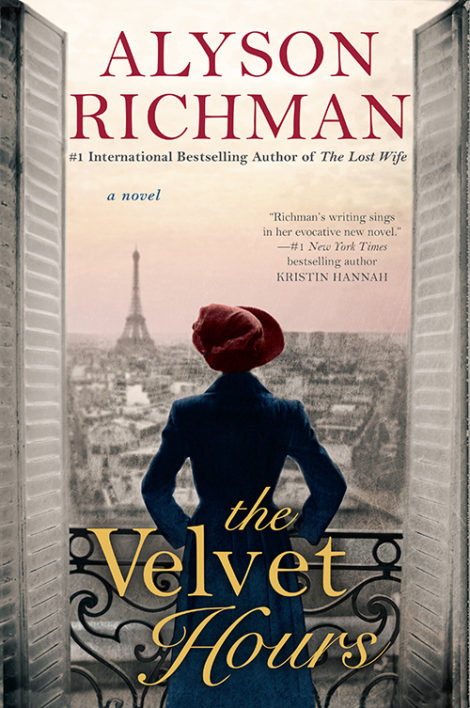
THE VELVET HOURS
From the international bestselling author of The Lost Wife and The Garden of Letters, comes a story—inspired by true events—of two women pursuing freedom and independence in Paris during WWII.
As Paris teeters on the edge of the German occupation, a young French woman closes the door to her late grandmother’s treasure-filled apartment, unsure if she’ll ever return.
An elusive courtesan, Marthe de Florian cultivated a life of art and beauty, casting out all recollections of her impoverished childhood in the dark alleys of Montmartre. With Europe on the brink of war,
From the international bestselling author of The Lost Wife and The Garden of Letters, comes a story—inspired by true events—of two women pursuing freedom and independence in Paris during WWII.
As Paris teeters on the edge of the German occupation, a young French woman closes the door to her late grandmother’s treasure-filled apartment, unsure if she’ll ever return.
An elusive courtesan, Marthe de Florian cultivated a life of art and beauty, casting out all recollections of her impoverished childhood in the dark alleys of Montmartre. With Europe on the brink of war, she shares her story with her granddaughter Solange Beaugiron, using her prized possessions to reveal her innermost secrets. Most striking of all are a beautiful string of pearls and a magnificent portrait of Marthe painted by the Italian artist Giovanni Boldini. As Marthe’s tale unfolds, like velvet itself, stitched with its own shadow and light, it helps to guide Solange on her own path.
Inspired by the true account of an abandoned Parisian apartment, Alyson Richman brings to life Solange, the young woman forced to leave her fabled grandmother’s legacy behind to save all that she loved.
- Berkley
- Paperback
- September 2016
- 384 Pages
- 9780425266267
About Alyson Richman
Alyson Richman is the international bestselling author of The Garden of Letters, The Lost Wife, The Last Van Gogh, The Rhythm of Memory, and The Mask Carver’s Son. She lives in Long Island, New York, with her husband and two children.
Praise
“Alyson Richman’s writing sings in her evocative new novel set in Paris at the dawn of World War II. The Velvet Hours is a beautiful and compelling portrait of two women facing their unknown past and an unimaginable future as their world begins to crumble.”—Kristin Hannah, #1 New York Times bestselling author of The Nightingale
“A book as full of treasures as the Paris apartment that inspired it….A masterful mix of the glamour of the Belle Epoque and the shadows of impending war.”—New York Times bestselling author Lauren Willig
“Richman develops an enthralling saga of two women—alternating between the late 1800’s and 1930’s—based on an actual Paris apartment. The lush atmosphere of the Belle Epoque and the stress of the coming war, the wonderful relationship between the women along with the fascinating historical backdrops draw readers into a lavish, beautifully written novel. It’s nearly impossible to put down and so moving that fans of The Nightingale and WW II novels will be enthralled and delighted.”—RT Book Reviews
Discussion Questions
1. The author references shadow and light in the novel. Discuss the aspects of shadow and light in Marthe de Florian’s life, as well as in Solange’s. Do you think both women come to terms with their pasts at the end of their lives? Or is there an element of regret?
2. Charles gives Marthe the gift of the pearls partly as a gift of beauty, but also as a gift of financial security. Do you think Marthe does the right thing when she sells the necklace?
3. Marthe is not educated, yet she is immensely curious. How would you describe her self-education? Do you think her material possessions reflect her pursuit of knowledge?
4. Marthe belongs to the demimondaine, the world of secret pleasure. What do you think of Marthe being a kept woman? Do you think it enabled her to be more liberated than married women in French society, or was her life more restricted?
5. Discuss the essential role the Barcelona Haggadah played in the novel. For example, it enables Solange to learn more about her ancestry, it brings her into the Armels’ bookstore and also, in the end, enables Solange and the Armels to gain safe passage. What else did the Haggadah bring to the overall story?
6. Above all, Marthe loves art and beauty. The author describes the sumptuous furnishings in the apartment, the butterfly- and bird-painted china, the fresh flowers, the rose-scented baths, and the gold-embossed stationery. Do we have these rituals of beauty in the twenty-first century? Are there any of these lost rituals that you’d like to bring back into your daily life?
7. Solange and Marthe forge an unlikely friendship. What do you think they each teach each other through their friendship?
8. Solange says: “What I realized at that moment was that my grandmother believed that as long as the apartment remained the way she had created it—her portrait above the mantel, her collection of porcelains, and the other pieces of art she had hand selected—she was convinced her memory would also not be extinguished.” Do you think that heirlooms help us maintain a memory of our loved ones, or are our shared stories what help connect us to the past? Are the two linked? How? Is one more important than the other? Do you own something that is linked with a story, and does it connect you with the past?
